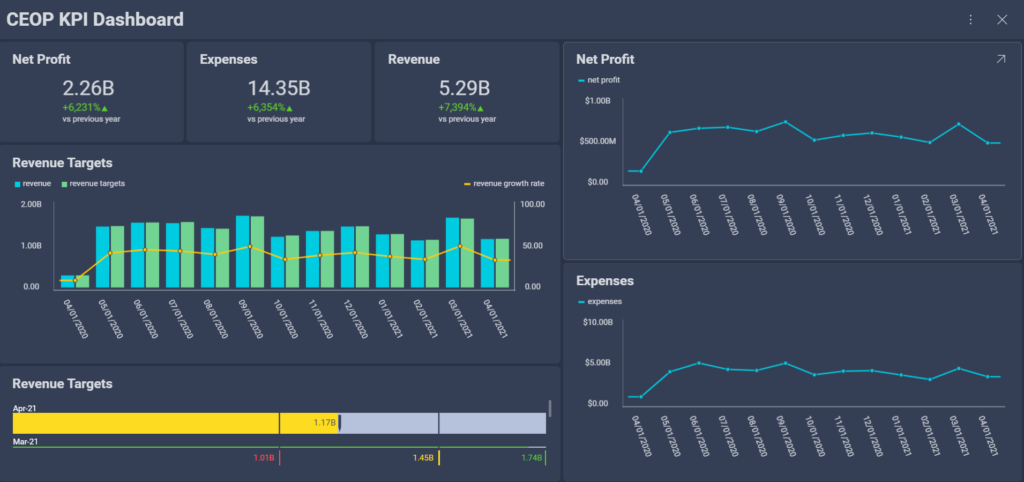
How Stephen Gould Scaled Its Capacity by 30% without Making a Single Hire
CEOs need easy and quick access to their KPIs – they need a CEO KPI dashboard that allows them to monitor how their business is performing at a given time period.
According to a series of interviews conducted by Harvard Business Review, CEOs are primarily concerned with three major challenges: attracting and retaining top talent, operating in a global market, and managing business transformation amid evolving regulations. These issues are significant, but they share a common theme—the need for timely, actionable insights to inform decision-making.
With limited time and a multitude of responsibilities—whether managing internal politics, overseeing growth strategies, or outmaneuvering competitors—it’s easy for tracking KPIs to slip through the cracks. However, these performance indicators are the foundation for business success, ensuring teams stay aligned with overall objectives.
While not every KPI applies to every business, there are several key metrics that CEOs across industries should monitor closely. Having these KPIs readily available—whether you’re on the plane, between meetings, or starting your day with a cup of coffee—can ensure your business remains on the right track.
Key Performance Indicators (KPIs) are measurable values that demonstrate how effectively a company is achieving its business goals. These metrics allow CEOs and leadership teams to gauge performance and identify areas that need improvement, offering a clear focus for strategic and operational decisions. As Peter Drucker famously said, “What gets measured gets done,” highlighting the power of KPIs in driving organizational success.
1. Net Profit
Net profit is a fundamental metric for assessing a company’s financial health. It shows how much profit your business is generating after all expenses have been deducted from total revenue. Regularly tracking net profit ensures you make informed decisions, whether they’re short-term financial adjustments or long-term strategic shifts.
2. Progress Toward Targets
Monitoring progress toward quarterly, annual, and long-term goals is essential for keeping your business on track. This KPI provides a clear comparison of actual versus expected outcomes, offering insights into where your company is excelling and where it may need adjustments.
3. Revenue Growth Rate
Revenue growth is a critical indicator of how well your business is expanding. CEOs need instant access to revenue data to determine which areas are contributing to growth and which might be underperforming. This metric is key for understanding market trends, identifying new opportunities, and reallocating resources effectively.
4. Expenses
Expenses—whether related to staffing, operations, or technology—are a significant drain on profitability. A CEO dashboard should break down expenses to provide a clear picture of where money is being spent and where cost reductions might be possible.
5. Revenue per Employee
This KPI is crucial for understanding the productivity of your workforce. It measures how much revenue each employee generates, helping you determine whether you’re maximizing efficiency and justifying your staffing levels.
6. Employee Engagement
A motivated, engaged workforce is key to driving productivity and achieving business goals. Regularly tracking employee engagement through surveys and feedback mechanisms ensures that your team remains committed and aligned with your company’s objectives.
7. Profit per Customer
This metric helps CEOs understand the profitability of their customer base by measuring how much profit each customer generates. It’s a critical KPI for making decisions about customer retention, acquisition strategies, and personalized marketing efforts.
8. Order Fulfillment Cycle Time
Efficiency in order fulfillment directly impacts customer satisfaction and cash flow. Monitoring the time it takes to fulfill orders helps you identify bottlenecks and areas for improvement, ensuring faster invoicing and happier customers.
9. Project Completion Rate
Tracking the percentage of completed projects is essential for understanding overall productivity and operational efficiency. A dashboard that visualizes project status can help identify delays, resource issues, or workflow inefficiencies, allowing CEOs to take corrective action.
10. Downtime
Downtime, whether due to equipment failure, supply chain delays, or staff absenteeism, can have a significant impact on business performance. Monitoring downtime trends helps uncover underlying issues and enables you to take preventive measures to avoid future disruptions.
Having access to these KPIs in a CEO dashboard empowers business leaders to make data-driven decisions in real time. A well-designed dashboard should be customizable and intuitive, providing the insights you need when you need them.
By implementing a KPI dashboard through a platform like Slingshot, CEOs can unify their business data, track performance metrics seamlessly, and collaborate effectively with their teams. Slingshot’s dashboard capabilities allow for visualizations that make complex data simple, ensuring you stay focused on what matters most—driving growth and achieving long-term success.

If you’re working on creating a CEO KPI dashboard, the KPIs listed above provide a solid foundation. Tailor them to fit your business’s unique goals and challenges, and regularly review and adjust them as your business evolves. The right set of KPIs can make the difference between reactive decisions and proactive leadership.